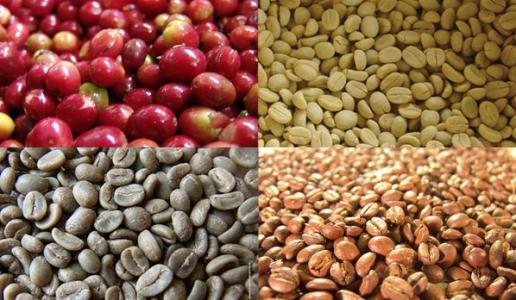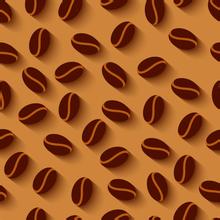Flavor characteristics of Brazilian coffee beans in Brazilian half-sun treatment story of Brazilian coffee beans
A brief introduction to the flavor description and acidity of solarization and Brazilian half-sun.
Brazilian coffee fields are endless and are mostly harvested mechanically in order to meet the economic benefits. When 75% of the coffee fruit in the coffee garden turns red, mechanical harvesting is started, followed by the same pre-washing operation, which is moved into the sink to remove floating beans, sift out the sunken beans, and then use a large pulp screening machine to dig out the pulp and remove the pods covered with pectin. The next stage is separate from the washing method: the sticky pods do not need to be moved into the tank to ferment, but to the outdoor bean drying farm. Because of the dry climate in Brazil, the sticky pectin on the pods will harden in about a day or so. Then use a large number of manpower to turn up and down, so that the pods dry evenly inside and outside, so as not to return to moisture and stink. In about two to three days, with the help of the natural force of Yangguan and dry climate, pods can achieve a certain degree of dehydration.
Brazilian coffee fields are endless and are mostly harvested mechanically in order to meet the economic benefits. When 75% of the coffee fruit in the coffee garden turns red, mechanical harvesting is started, followed by the same pre-washing operation, which is moved into the sink to remove floating beans, sift out the sunken beans, and then use a large pulp screening machine to dig out the pulp and remove the pods covered with pectin. The next stage is separate from the washing method: the sticky pods do not need to be moved into the tank to ferment, but to the outdoor bean drying farm. Because of the dry climate in Brazil, the sticky pectin on the pods will harden in about a day or so. Then use a large number of manpower to turn up and down, so that the pods dry evenly inside and outside, so as not to return to moisture and stink. In about two to three days, with the help of the natural force of the sun pass and dry climate, the pods can achieve a certain degree of dehydration. Then further dry with a dryer, the water content is reduced to 10.5%, and the pods are stored in a special container for about 10 days to further mature, in order to stabilize the quality, remove sheep skins (pods) before export, remove coffee beans, and pack them in stages.
Washing is the most technical way to pick up beans, and the quality of coffee is ensured through multiple sieving procedures. First move the red fruit and half-green and half-red fruit that have sunk into the sink into a large or medium-sized pulp screening machine (PulpingMachines). It is cleverly designed to mechanically press the fruit into a sieve hole, which is exactly the size of the pod (both sheepskin-wrapped coffee beans) to filter out the flesh outside the pod-using unripe fruit to be harder. Pods are not easy to squeeze out, but mature fruits are soft, and pods are easily squeezed out to ward off unripe beans and filter out the sweetest pods, so the setting of machine thrust is very important. too much force will squeeze out hard and astringent unripe beans, damaging the quality of fine beans. The general push force is set to allow 3% red fruit pods not to be squeezed into the sieve hole to ensure that all stiff green fruits are removed.

Important Notice :
前街咖啡 FrontStreet Coffee has moved to new addredd:
FrontStreet Coffee Address: 315,Donghua East Road,GuangZhou
Tel:020 38364473
- Prev

A brief introduction to the taste characteristics of Yunnan geisha coffee beans, the characteristics of varieties, price and flavor description.
Yunnan Geisha Coffee Bean Taste characteristics Variety characteristics Price Flavor description Jade Manor won the BOP (Best Coffee in BEST OF PANAMA Panama) competition five times in 2004, 2006, 2007, 2009 and 2010, and won the championship of the American Fine Coffee Association Cup Test Competition for three consecutive years in 2005, 2006 and 2007. Its scenery is for a while.
- Next

Flavor Description of Honduran Coffee Bean Taste Grind Scale Processing Manor Variety
Honduras coffee beans flavor description of the taste of grinding scale processing method Manor varieties Honduras coffee has a rich and mellow taste, taste not astringent acid, alcohol and aroma are very high, quite with personality. Honduran coffee can be roasted to varying degrees, resulting in multiple layers of flavor. Medium roasting brings out the sweetness of the beans to the extreme, while deep roasting brings out the bitterness
Related
- Detailed explanation of Jadeite planting Land in Panamanian Jadeite Manor introduction to the grading system of Jadeite competitive bidding, Red bid, Green bid and Rose Summer
- Story of Coffee planting in Brenka region of Costa Rica Stonehenge Manor anaerobic heavy honey treatment of flavor mouth
- What's on the barrel of Blue Mountain Coffee beans?
- Can American coffee also pull flowers? How to use hot American style to pull out a good-looking pattern?
- Can you make a cold extract with coffee beans? What is the right proportion for cold-extracted coffee formula?
- Indonesian PWN Gold Mandrine Coffee Origin Features Flavor How to Chong? Mandolin coffee is American.
- A brief introduction to the flavor characteristics of Brazilian yellow bourbon coffee beans
- What is the effect of different water quality on the flavor of cold-extracted coffee? What kind of water is best for brewing coffee?
- Why do you think of Rose Summer whenever you mention Panamanian coffee?
- Introduction to the characteristics of authentic blue mountain coffee bean producing areas? What is the CIB Coffee Authority in Jamaica?

